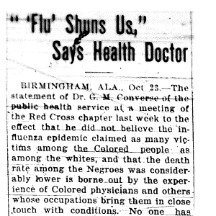On November 2, 1918, as the Spanish Flu pandemic marched around the world and eventually killing more than 50,000,000 people in two years, a headline in the Cleveland Advocate, a Black newspaper, read: “‘Flu' Shuns Us,’ Says Health Doctor.” A study published in the July 12, 2019 International Journal of Environmental Research and Public Health reinforced the then commonly held belief that Black people were not getting the flu, or dying from it, the way White people were. “The only year in the 20th century when Black people in the USA had lower influenza mortality than White people was 1918,” wrote Helene Økland and Svenn-Erik Mamelund in The Journal.
Despite the injustices spawned by segregation, it may have functioned as a de facto quarantine, limiting the exposure Blacks, generally, and of Queen Anne Town, Maryland, in particular, to the Spanish Flu.
In 1918 Queen Anne Town, Black physician and Mount Nebo Colored (Elementary) School teacher Dr. William Lane Watkins took to his horse and buggy for the family’s long journey to Baltimore to see to the burial of his two daughters, Maud and Blanche. The road north passed close to Camp [Fort] Meade, sixteen miles from the city, where it all began.
In reality, however, a deadly influenza was sweeping across the country with the ferocity of a wind storm, cutting down Americans in their prime. Right or wrong, President Wilson and other bureaucrats contended that the War had to take priority, and citizens’ morale and sense of patriotism
had to remain high.
According to Baltimore News, September 18, 1918 edition, there was an “appearance of the Spanish Flu in New England … then, in a flash, the flu was at Fort Meade (MD) … A week later, it had hit the city.” Without telephone, or other means of speedy communication, and passage of the Sedition Act in May, 1918 (which curtailed the free speech rights of U.S. citizens during time of war), the Watkins, and their Queen Anne Town neighbors were insulated from news of a deadly influenza outbreak rapidly spreading throughout the Baltimore region and around the country.
The Flu Shuns Us, Says Health Doctor
Praising the Past


Unbeknownst to her parents, Maud, the youngest Watkins girl, who was living in Erie, Ohio at the time, traveled to Baltimore to help care for her ill sister, Blanche, 34. Although the precise dates of her sojourn are unclear, presumably, Maud cared for her sister during the fall of 1918, characterized as the “Second Wave.” Over a 90-day period, starting in September, the influenza evolved from “a few reported cases at Fort Meade” into a city-wide epidemic - at least 75,000 Baltimoreans caught the lethal flu; 4,125 died. The devastation now reached the Watkins family. Both daughters were dead. Maud, 29, died six days after her older sister.
With benefit of hindsight, health experts have concluded that troop movements, in the build up to World War I, caused the Spanish Flu to spread. Soldiers carried the virus with them as they transferred from base to base, and boarded trains and ships for Europe. Certain health and government officials at first characterized the virus as the old-fashioned grippe, or common cold. In reality, however, a deadly influenza was sweeping across the country with the ferocity of a wind storm, cutting down Americans in their prime. Right or wrong, President Wilson and other bureaucrats contended that the War had to take priority, and citizens’ morale and sense of patriotism had to remain high.
Tales from Historic Mount Nebo Series is an ongoing series of stories about people connected to the historic Mount Nebo African American Episcopal Church, Cemetery, and/or Colored School in Bowie, Maryland. Click the link below for the original story and for links to this and other stories in the series.
Black Lives Matter in Death, Too – Mt. Nebo AME Preserves Historic Cemetery
With benefit of hindsight, health experts have concluded that troop movements, in the build up to World War I, caused the Spanish Flu to spread. Soldiers carried the virus with them as they transferred from base to base, and boarded trains and ships for Europe. Certain health and government officials at first characterized the virus as the old-fashioned grippe, or common cold. In reality, however, a deadly influenza was sweeping across the country with the ferocity of a wind storm, cutting down Americans in their prime. Right or wrong, President Wilson and other bureaucrats contended that the War had to take priority, and citizens’ morale and sense of patriotism had to remain high.
Tales from Historic Mount Nebo Series is an ongoing series of stories about people connected to the historic Mount Nebo African American Episcopal Church, Cemetery, and/or Colored School in Bowie, Maryland. Click the link below for the original story and for links to this and other stories in the series.
Black Lives Matter in Death, Too – Mt. Nebo AME Preserves Historic Cemetery
Advertisers | Contact Us | Events | Links | Media Kit | Our Company | Payments Pier
Press Room | Print Cover Stories Archives | Electronic Issues and Talk Radio Archives | Writer's Guidelines






